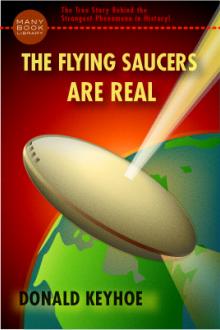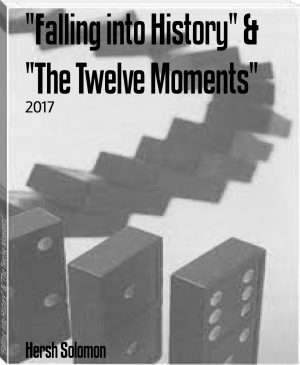The Expression of Emotion in Man and Animals by Charles Darwin (adult books to read TXT) 📕

- Author: Charles Darwin
- Performer: -
Book online «The Expression of Emotion in Man and Animals by Charles Darwin (adult books to read TXT) 📕». Author Charles Darwin
He who will attend to the starting of his horse, when tired and fresh, will perceive how perfect is the gradation from a mere glance at some unexpected object, with a momentary doubt whether it is dangerous, to a jump so rapid and violent, that the animal probably could not voluntarily whirl round in so rapid a manner.
The nervous system of a fresh and highly-fed horse sends its order to the motory system so quickly, that no time is allowed for him to consider whether or not the danger is real.
After one violent start, when he is excited and the blood flows freely through his brain, he is very apt to start again; and so it is, as I have noticed, with young infants.
A start from a sudden noise, when the stimulus is conveyed through the auditory nerves, is always accompanied in grown-up persons by the winking of the eyelids.[13] I observed, however, that though my infants started at sudden sounds, when under a fortnight old, they certainly did not always wink their eyes, and I believe never did so. The start of an older infant apparently represents a vague catching hold of something to prevent falling.
I shook a pasteboard box close before the eyes of one of my infants, when 114
days old, and it did not in the least wink; but when I put a few comfits into the box, holding it in the same position as before, and rattled them, the child blinked its eyes violently every time, and started a little.
It was obviously impossible that a carefully-guarded infant could have learnt by experience that a rattling sound near its eyes indicated danger to them.
But such experience will have been slowly gained at a later age during a long series of generations; and from what we know of inheritance, there is nothing improbable in the transmission of a habit to the offspring at an earlier age than that at which it was first acquired by the parents.
From the foregoing remarks it seems probable that some actions, which were at first performed consciously, have become through habit and association converted into reflex actions, and are now so firmly fixed and inherited, that they are performed, even when not of the least use,[14] as often as the same causes arise, which originally excited them in us through the volition. In such cases the sensory nerve-cells excite the motor cells, without first communicating with those cells on which our consciousness and volition depend.
It is probable that sneezing and coughing were originally acquired by the habit of expelling, as violently as possible, any irritating particle from the sensitive air-passages. As far as time is concerned, there has been more than enough for these habits to have become innate or converted into reflex actions; for they are common to most or all of the higher quadrupeds, and must therefore have been first acquired at a very remote period.
Why the act of clearing the throat is not a reflex action, and has to be learnt by our children, I cannot pretend to say; but we can see why blowing the nose on a handkerchief has to be learnt.
[13] Muller remarks (`Elements of Physiology,’ Eng. tr. vol. ii. p. 1311) on starting being always accompanied by the closure of the eyelids.
[14] Dr. Maudsley remarks (`Body and Mind,’ p. 10) that “reflex movements which commonly effect a useful end may, under the changed circumstances of disease, do great mischief, becoming even the occasion of violent suffering and of a most painful death.”
It is scarcely credible that the movements of a headless frog, when it wipes off a drop of acid or other object from its thigh, and which movements are so well coordinated for a special purpose, were not at first performed voluntarily, being afterwards rendered easy through long-continued habit so as at last to be performed unconsciously, or independently of the cerebral hemispheres.
So again it appears probable that starting was originally acquired by the habit of jumping away as quickly as possible from danger, whenever any of our senses gave us warning. Starting, as we have seen, is accompanied by the blinking of the eyelids so as to protect the eyes, the most tender and sensitive organs of the body; and it is, I believe, always accompanied by a sudden and forcible inspiration, which is the natural preparation for any violent effort. But when a man or horse starts, his heart beats wildly against his ribs, and here it may be truly said we have an organ which has never been under the control of the will, partaking in the general reflex movements of the body.
To this point, however, I shall return in a future chapter.
The contraction of the iris, when the retina is stimulated by a bright light, is another instance of a movement, which it appears cannot possibly have been at first voluntarily performed and then fixed by habit; for the iris is not known to be under the conscious control of the will in any animal.
In such cases some explanation, quite distinct from habit, will have to be discovered. The radiation of nerve-force from strongly-excited nerve-cells to other connected cells, as in the case of a bright light on the retina causing a sneeze, may perhaps aid us in understanding how some reflex actions originated. A radiation of nerve-force of this kind, if it caused a movement tending to lessen the primary irritation, as in the case of the contraction of the iris preventing too much light from falling on the retina, might afterwards have been taken advantage of and modified for this special purpose.
It further deserves notice that reflex actions are in all probability liable to slight variations, as are all corporeal structures and instincts; and any variations which were beneficial and of sufficient importance, would tend to be preserved and inherited. Thus reflex actions, when once gained for one purpose, might afterwards be modified independently of the will or habit, so as to serve for some distinct purpose.
Such cases would be parallel with those which, as we have every reason to believe, have occurred with many instincts; for although some instincts have been developed simply through long-continued and inherited habit, other highly complex ones have been developed through the preservation of variations of pre-existing instincts—
that is, through natural selection.
I have discussed at some little length, though as I am well aware, in a very imperfect manner, the acquirement of reflex actions, because they are often brought into play in connection with movements expressive of our emotions; and it was necessary to show that at least some of them might have been Erst acquired through the will in order to satisfy a desire, or to relieve a disagreeable sensation.
Associated habitual movements in the lower animals.—
I have already given in the case of Man several instances of movements associated with various states of the mind or body, which are now purposeless, but which were originally of use, and are still of use under certain circumstances. As this subject is very important for us, I will here give a considerable number of analogous facts, with reference to animals; although many of them are of a very trifling nature. My object is to show that certain movements were originally performed for a definite end, and that, under nearly the same circumstances, they are still pertinaciously performed through habit when not of the least use.
That the tendency in most of the following cases is inherited, we may infer from such actions being performed in the same manner by all the individuals, young and old, of he same species.
We shall also see that they are excited by the most diversified, often circuitous, and sometimes mistaken associations.
Dogs, when they wish to go to sleep on a carpet or other hard surface, generally turn round and round and scratch the ground with their fore-paws in a senseless manner, as if they intended to trample down the grass and scoop out a hollow, as no doubt their wild parents did, when they lived on open grassy plains or in the woods. Jackals, fennecs, and other allied animals in the Zoological Gardens, treat their straw in this manner; but it is a rather odd circumstance that the keepers, after observing for some months, have never seen the wolves thus behave.
A semi-idiotic dog—and an animal in this condition would be particularly liable to follow a senseless habit—was observed by a friend to turn completely round on a carpet thirteen times before going to sleep.
Many carnivorous animals, as they crawl towards their prey and prepare to rush or spring on it, lower their heads and crouch, partly, as it would appear, to hide themselves, and partly to get ready for their rush; and this habit in an exaggerated form has become hereditary in our pointers and setters.
Now I have noticed scores of times that when two strange dogs meet on an open road, the one which first sees the other, though at the distance of one or two hundred yards, after the first glance always lowers its bead, generally crouches a little, or even lies down; that is, he takes the proper attitude for concealing himself and {illust. caption = for making a rush or FIG. 4.—Small dog watching a cat on a spring, although the road table.
From a photograph taken is quite open and The distance Mr. Rejlander.} great.
Again, dogs of all kinds when intently watching and slowly approaching their prey, frequently keep one of their fore-legs doubled up for a long time, ready for the next cautious step; and this is eminently characteristic of the pointer. But from habit they behave in exactly the same manner whenever their attention is aroused (fig. 4). I have seen a dog at the foot of a high wall, listening attentively to a sound on the opposite side, with one leg doubled up; and in this case there could have been no intention of making a cautious approach.
Dogs after voiding their excrement often make with all four feet a few scratches backwards, even on a bare stone pavement, as if for the purpose of covering up their excrement with earth, in nearly the same manner as do cats.
Wolves and jackals behave in the Zoological Gardens in exactly the same manner, yet, as I am assured by the keepers, neither wolves, jackals, nor foxes, when they have the means of doing so, ever cover up their excrement, any more than do dogs.
All these animals, however, bury superfluous food. Hence, if we rightly understand the meaning of the above cat-like habit, of which there can be little doubt, we have a purposeless remnant of an habitual movement, which was originally followed by some remote progenitor of the dog-genus for a definite purpose, and which has been retained for a prodigious length of time.
Dogs and jackals[15] take much pleasure in rolling and rubbing their necks and backs on carrion. The odour seems delightful to them, though dogs at least do not eat carrion.
Mr. Bartlett has observed wolves for me, and has given them carrion, but has never seen them roll on it. I have heard it remarked, and I believe it to be true, that the larger dogs, which are probably descended from wolves, do not so often roll in carrion as do smaller dogs, which are probably descended from jackals.
When a piece of brown biscuit is offered to a terrier of mine and she is not hungry (and I have heard of similar instances), she first tosses it about and worries it, as if it were a rat or other prey;





Comments (0)